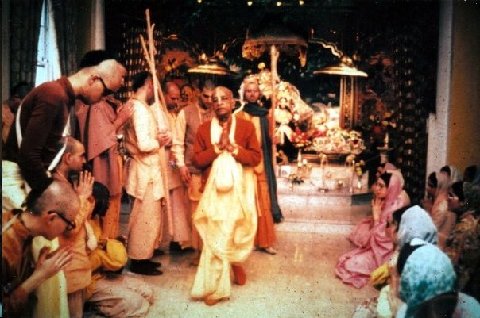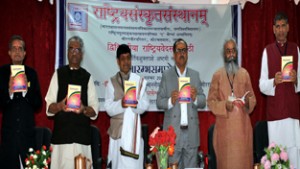
Dharmakala Cooking Biscuits in RVC Temple devotee kitchen – 1984.
By Madhava Smullen
Dharmakala Dasi’s destiny seemed set from the start – she grew up with the smell of fresh baked bread and cookies lingering throughout her home.
“My parents had eight kids, so we didn’t really go out to eat – my mother just cooked constantly to feed us all,” she says. “So being around it all the time, I started cooking myself when I was a little kid. I baked my first brownies at the age of seven.”
But with all that good old-fashioned home cooking, Dharmakala never tasted anything quite like the Sunday Feast at the Hare Krishna temple in Ocean City, Maryland, in 1972 – “It was totally out of this world,” she says. And it was this that would lead to her cooking for Lord Krishna, and becoming synonymous with New Vrindaban’s celebrated history of prasadam baking.
First, though, she joined ISKCON in Ocean City, then moved to New York, where she was initiated by Srila Prabhupada in 1973. There, she began baking “Prabhupada cookies” and offered her first cake to the Lord, a huge multi-layered whipped mango affair for Radhastami.

Srila Prabhupada outside the Henry Street Temple 1973 – Dharmakala offering obeisances on left.
In July 1974, Dharmakala decided to move to New Vrindaban, West Virginia, where she received second initiation the following year, and thereafter began cooking daily for the Deities for approximately the next fifteen years.
New Vrindaban, a remote, austere rural community, couldn’t have been more different from New York City. Dharmakala prepared the legendary 4pm offering of fried curd, milk sweets, cookies, cheesecake, and more using a wood oven and wood stove that had to be constantly stoked.
“There wasn’t anything electric at all at the Bahulaban kitchen – everything had to be done by hand,” she says. “The curd used in the cheesecake had to be kneaded out by hand to smooth it, as there were no blenders.”
The upside to the simple life was that all the dairy products were made from the milk of the sacred village’s protected cows, which was thick with cream. It was this cream that was separated from the milk and used in Dharmakala’s much coveted maha-prasadam condensed milk, or kheer, which was often served with peaches, strawberries and bananas.
“The feasts and Deity offerings in Bahulaban back then were so outrageously opulent you wouldn’t believe it,” Dharmakala says.
Until 1989 – during which the kitchen moved from Bahulaban to Radha Vrindabanchandra’s current temple – Dharmakala cooked full-time for the Deities and devotees.
As well as the 4pm offering, she also made popcorn, cereal, breadsticks and other snacks for the devotees in the afternoon, and cooked chapatis over gas flames on a large griddle for lunch.

New Vrindaban Bahulavan 1975 (Dharmakala pictured)
“Together our team would do a thousand chapatis a day,” she says.
But over the years, Dharmakala became most famous for her baking.
In the mornings, she often baked bread for the devotees. On Sunday feasts and festivals, she would make orange cake, date nut bars, or apple and rhubarb strawberry crisp for 800 people, sending huge trays to locations all over the community.
And nothing was ever half-baked – if you’ll pardon the pun – with Dharmakala.
“Whatever I did, I would do to the best of my ability,” she says. “For instance, instead of just making normal sugar cookies for the 4pm offering, I’d make coconut walnut squares or sandwich cookies. That would be two Prabhupada cookies with a filling of fresh strawberry jam and an icing glaze on top.”
Dharmakala worked very hard, often spending eleven-hour days from 10am to nearly 9pm in the kitchen, with no days off.
“I remember being eight-and-a-half months pregnant with my daughter Dinataruni one Thanksgiving, and baking as many pumpkins as I could for pumpkin pie well into the night, because we didn’t have any canned pumpkin,” she says. “The next morning, I went in, made the crusts, and finished up ten trays of pie with fresh whipped cream on top. All while I was about to pop!”
But for Dharmakala, the memories are good, full of the kind of loving exchanges between godbrothers and godsisters that Srila Pabhupada formed ISKCON to facilitate.

Prabhupada 1973 NY Henry Street Temple – Dharmakala lower right corner
“Kuladri’s wife Kutila taught me how to make milk sweets; Prabhupada’s servant Nanda Kumar oversaw the kitchen; and Hari-Kirtana, Vraja Kumari and Gita from Canada were my chapati crew,” she says. “Everybody was working together, and it was such good teamwork and camaraderie. It was devotional service for us, and we just wanted to make a nice lunch for Krishna. You just had that intention that it was going to turn out great, and it always did.”
After 1989, Dharmakala stopped serving full-time at the temple kitchen, but continued to make cakes for weddings, birthdays, anniversaries and other celebrations held in New Vrindaban, a service she offers to this day.
“I make chocolate, carob, and vanilla cakes, carrot cakes, and more,” she says. “Whatever people want. I always use organic, non-GMO ingredients. I use organic flour, demerrara sugar or Sucanat, and for vegan cakes, I make my own soymilk from organic soybeans.”
In 1995, Dharmakala started her own company, “World’s Best Cookie,” selling to health food stores and coffee shops along the East Coast. Her products include raisin, chocolate-chip, carob-chip, and pumpkin-spice oatmeal cookies, along with wheat-free raisin and chocholate-chip options, and an energy cookie.

Dharmakala Baking Worlds Best Cookies
So far, she has made 500,000 of these, all by hand, in pink ovens decorated with hearts and the inscription “Baked with the intention of love,” at her bakery on the ECO-V farm. What’s more, each and every cookie is offered to Srila Prabhupada, whose murti oversees the bakery from his vyasasana. He reminds Dharmakala of a special loving moment.
“I remember that when Prabhupada visited New Vrindaban in 1976, he was giving out cookies in the tiny Bahulaban temple room,” she says. “It was absolutely packed with devotees, and I was eight months pregnant with my son Suddha Sattva and afraid that I’d get pushed or shoved. So I hid in a corner to the side of his vyasasana, and just held out my hand, and he gave me a cookie. I put it in my beadbag, then held out my hand again, and he gave me another cookie. And again, and again. I left with six cookies!”
Today, after decades of service cooking for the Lord and his devotees and raising her five children, Dharmakala is still living in New Vrindaban. And just as it did back in the ‘70s, it’s the camaraderie and devotee association that keeps her there.
“My friends are the reason,” she says. “We all built this place together. So we’re like family.”
And when asked what advice she has for the next wave of New Vrindaban residents, Dharmakala suggests trying out the simplicity that made those early days special.
“Turn off the electric, get away from your computer, and see what you can manifest,” she says. “And, in the kitchen as well as in life, work from your heart!”

Dharmakala’s Coconut Walnut Squares
“I love this recipe because it’s super rich and opulent. It has been a favorite at New Vrindaban for years, since I used to make it in the Deity kitchen for the pleasure of Sri Sri Radha Vrindabanchandra.”
Makes 18 squares.
Ingredients:
1st layer:
1 cup of butter (melted)
½ cup of brown sugar
2 ½ cups of flour
2nd layer:
1/3 cup of yogurt
2 cups of brown sugar
¼ cup of flour
1 cup of shredded coconut
1 ½ teaspoons of baking powder
½ cup of chopped walnuts
2 tablespoons of lemon juice
1 teaspoon of grated lemon rind
½ teaspoon of salt
Glaze (optional):
1 ½ cup powdered sugar
2 tablespoons of butter (melted)
3 tablespoons of lemon juice.
Directions:
To make the first layer, mix the ingredients together and press firmly into a 9 x 12 inch baking tray.
Before putting the first layer into the pan, make sure the inside of the tray is lightly greased with butter (or vegetable oil). Next, sprinkle a small amount of flour over the butter (or use parchment paper). This will help minimize sticking.
Bake the first layer for approximately 10 minutes at 400 F. Remove from the oven and and cool slightly.
To make the second layer, mix all ingredients and spread over top of the first layer.
Bake at 350 F for around 20-25 minutes, until golden brown. Remove tray from oven and allow to cool.
For the glaze, combine ingredients together, stir until smooth and drizzle over the entire tray.
Finally, cut into 18 good-sized squares, offer and serve.






















